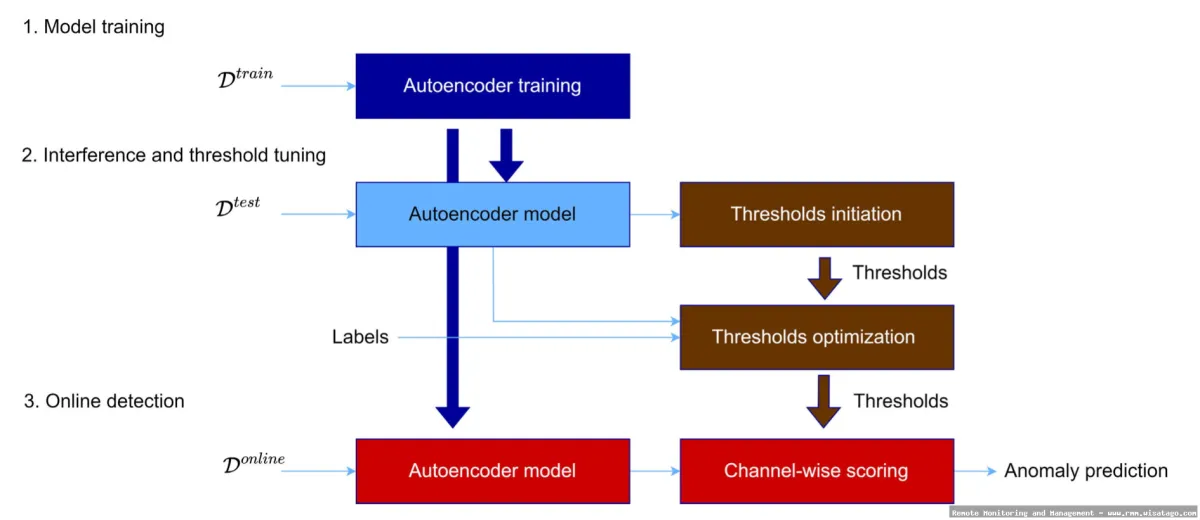Remote Monitoring and Management (RMM) platforms have become indispensable tools for IT professionals. They provide a centralized hub for managing and maintaining IT infrastructure, allowing for proactive issue resolution, automated tasks, and improved overall system health. However, the sheer volume of data generated by these platforms can be overwhelming, making it difficult to identify genuine anomalies that require immediate attention. This is where the power of Artificial Intelligence (AI) comes into play, offering a smarter, more efficient way to detect and respond to potential problems.
Imagine sifting through thousands of log entries, performance metrics, and alerts every day, trying to pinpoint the one tiny deviation that signals a looming disaster. It’s like searching for a needle in a haystack! Traditional threshold-based alerting systems often generate a flood of false positives, leading to alert fatigue and wasted time. AI-powered anomaly detection, on the other hand, learns from historical data, understands normal system behavior, and automatically identifies deviations that fall outside those established patterns. This allows IT teams to focus on critical issues, reduce downtime, and improve overall operational efficiency.

This article will delve into the world of AI-powered anomaly detection in RMM platforms, exploring its core features, practical benefits, and the challenges involved in its implementation. We’ll examine how AI algorithms are used to analyze RMM data, identify suspicious patterns, and provide actionable insights. Whether you’re a seasoned IT professional looking to enhance your existing RMM setup or just curious about the potential of AI in IT management, this guide will provide a comprehensive overview of this transformative technology.
What is AI-Powered Anomaly Detection in RMM?
At its core, AI-powered anomaly detection in RMM involves leveraging machine learning algorithms to automatically identify unusual patterns or deviations from normal behavior within the data collected by the RMM platform. This data encompasses a wide range of metrics, including CPU utilization, memory usage, network traffic, disk I/O, application performance, and security logs. Instead of relying on static thresholds, AI models learn from historical data to establish a baseline of normal operation. Any significant departure from this baseline is flagged as an anomaly, indicating a potential problem that requires investigation.
Traditional Monitoring vs. AI-Powered Anomaly Detection
Traditional monitoring systems typically rely on predefined thresholds. For example, an alert might be triggered if CPU utilization exceeds 80% for a certain period. While this approach is simple to implement, it has several limitations:
- False Positives: Thresholds may be too sensitive, triggering alerts for normal fluctuations.
- False Negatives: Thresholds may be too broad, missing subtle anomalies that don’t cross the defined limits.
- Lack of Context: Thresholds don’t consider the context of the data. A CPU spike might be normal during a specific scheduled task but abnormal at other times.
- Manual Configuration: Setting and maintaining thresholds across a large and diverse IT environment can be time-consuming and error-prone.
AI-powered anomaly detection addresses these limitations by:
- Learning from Data: Algorithms automatically learn normal behavior patterns, eliminating the need for manual threshold configuration.
- Adaptive Thresholds: Thresholds dynamically adjust based on historical data and seasonality, reducing false positives and negatives.
- Contextual Analysis: AI models consider the context of the data, such as time of day, day of week, and recent events, to identify truly anomalous behavior.
- Proactive Detection: AI can identify subtle anomalies that might be missed by traditional monitoring, allowing for proactive problem resolution.
Key AI Algorithms Used in Anomaly Detection
Several machine learning algorithms are commonly used in AI-powered anomaly detection for RMM platforms. These include:
- Time Series Analysis: Algorithms like ARIMA (Autoregressive Integrated Moving Average) and Prophet are used to forecast future values based on historical data. Anomalies are detected when actual values deviate significantly from the predicted values.
- Clustering: Algorithms like K-means clustering group similar data points together. Anomalies are identified as data points that don’t belong to any cluster or belong to small, isolated clusters.
- Regression Analysis: Algorithms like linear regression and polynomial regression are used to model the relationship between different variables. Anomalies are detected when the actual values deviate significantly from the predicted values based on the regression model.
- Neural Networks: Deep learning models, such as autoencoders and recurrent neural networks (RNNs), can learn complex patterns in data and identify anomalies based on reconstruction error or prediction error.
- Support Vector Machines (SVMs): SVMs can be trained to classify data points as normal or anomalous.
Features of AI-Powered Anomaly Detection in RMM Platforms
Modern RMM platforms with integrated AI-powered anomaly detection offer a range of features designed to streamline IT management and improve operational efficiency.

Automated Anomaly Identification
The core feature is the ability to automatically identify anomalies across various IT systems and applications. The AI engine continuously analyzes data streams from servers, workstations, network devices, and cloud services, flagging any deviations from established baselines. This automation reduces the need for manual monitoring and allows IT teams to focus on more strategic tasks.
Real-time Alerting and Notifications
When an anomaly is detected, the RMM platform generates real-time alerts and notifications, informing IT staff about the potential issue. These alerts can be delivered via email, SMS, or integrated into ticketing systems, ensuring that critical problems are addressed promptly. The alerts typically include details about the anomaly, the affected system, and the severity level, allowing for informed decision-making.
Root Cause Analysis
Some AI-powered RMM platforms go beyond simple anomaly detection and offer root cause analysis capabilities. By analyzing related data points and dependencies, the AI engine can help identify the underlying cause of the anomaly, speeding up the troubleshooting process. This reduces the time it takes to resolve issues and minimizes downtime.
Predictive Analytics
AI can also be used to predict future problems based on historical trends and patterns. By identifying early warning signs, IT teams can take proactive measures to prevent issues from escalating. For example, AI might predict that a server is likely to run out of disk space based on its current growth rate, allowing administrators to add more storage before the problem occurs.
Customizable Thresholds and Rules
While AI automates much of the anomaly detection process, RMM platforms typically allow IT teams to customize thresholds and rules to fine-tune the system to their specific needs. This allows them to prioritize certain types of anomalies or adjust the sensitivity of the detection algorithms. For instance, a team might choose to receive immediate alerts for security-related anomalies but only receive daily summaries for performance-related issues.
Integration with Other IT Tools
AI-powered RMM platforms often integrate with other IT tools, such as ticketing systems, security information and event management (SIEM) systems, and configuration management databases (CMDBs). This integration allows for seamless data sharing and automated workflows, further streamlining IT management processes. For example, when an anomaly is detected, the RMM platform can automatically create a ticket in the ticketing system and assign it to the appropriate technician.

Benefits of Using AI-Powered Anomaly Detection in RMM
Implementing AI-powered anomaly detection in RMM platforms offers a wide array of benefits for IT teams and organizations.
Reduced Downtime
By proactively identifying and addressing potential problems before they escalate, AI helps reduce downtime and improve system availability. This is particularly crucial for businesses that rely heavily on their IT infrastructure to operate.
Improved Operational Efficiency
Automation and intelligent alerting free up IT staff to focus on more strategic tasks, such as planning, innovation, and security. This improves overall operational efficiency and allows IT teams to deliver more value to the business.
Enhanced Security
AI can detect security threats and vulnerabilities that might be missed by traditional security tools. By analyzing network traffic, user behavior, and log data, AI can identify suspicious patterns and alert IT staff to potential security breaches.
Lower IT Costs
By reducing downtime, improving efficiency, and preventing problems from escalating, AI helps lower overall IT costs. This includes reduced labor costs, lower hardware maintenance costs, and decreased business disruption costs.
Better Decision-Making
AI provides valuable insights into system performance, security threats, and potential problems. This information empowers IT teams to make better decisions and optimize their IT infrastructure.

Challenges of Implementing AI-Powered Anomaly Detection
While AI-powered anomaly detection offers significant benefits, there are also challenges involved in its implementation. Effective IT management often requires a robust system, and RMM plays a crucial role in that regard
.
Data Quality and Availability
AI models require high-quality, consistent data to function effectively. If the data is incomplete, inaccurate, or inconsistent, the AI engine may produce unreliable results. Ensuring data quality and availability is therefore crucial for successful implementation.
Algorithm Selection and Configuration
Choosing the right AI algorithms and configuring them appropriately can be challenging. Different algorithms are suited for different types of data and problems. IT teams may need to experiment with different algorithms and parameters to find the optimal configuration for their specific environment.
Integration with Existing Systems
Integrating AI-powered RMM platforms with existing IT tools and systems can be complex. Ensuring seamless data sharing and automated workflows requires careful planning and execution.
Training and Expertise
Implementing and managing AI-powered anomaly detection requires specialized skills and expertise. IT teams may need to invest in training and development to build the necessary skills or hire external consultants to assist with the implementation.
Explainability and Trust
Understanding why an AI model has flagged a particular anomaly can be challenging. Some AI algorithms are “black boxes,” making it difficult to interpret their decisions. Building trust in the AI system requires transparency and explainability.

Conclusion
AI-powered anomaly detection is transforming the way IT teams manage and maintain their infrastructure. By automating anomaly identification, providing real-time alerts, and offering root cause analysis capabilities, AI helps reduce downtime, improve operational efficiency, enhance security, and lower IT costs. While there are challenges involved in its implementation, the benefits of AI-powered anomaly detection far outweigh the risks. As AI technology continues to evolve, it will play an increasingly important role in IT management, enabling organizations to proactively address problems, optimize their IT infrastructure, and achieve their business goals. Embracing AI in RMM is no longer a luxury, but a necessity for staying competitive in today’s fast-paced digital landscape.
Conclusion
In conclusion, the integration of AI-powered anomaly detection into RMM platforms represents a significant leap forward in proactive IT management. By automating the identification of unusual behavior, these systems empower MSPs and IT departments to move beyond reactive firefighting and embrace a preventative approach. The capabilities discussed, including automated thresholding, predictive analysis, and context-aware alerting, offer the potential to dramatically reduce downtime, improve security posture, and ultimately, enhance the overall efficiency of IT operations.
The benefits are clear: reduced operational costs, improved service delivery, and a stronger security defense. As AI technology continues to evolve, its role in RMM platforms will only become more critical. Now is the time for organizations to explore how AI-powered anomaly detection can transform their IT management strategies. We encourage you to investigate the available solutions and consider how these powerful tools can help you unlock the full potential of your RMM platform and ensure a more resilient and secure IT infrastructure. Learn more about specific AI-driven RMM solutions by visiting our partner page at example.com/ai-rmm-solutions.
Frequently Asked Questions (FAQ) about AI-Powered Anomaly Detection in RMM Platforms
How can AI-powered anomaly detection within my Remote Monitoring and Management (RMM) platform help me proactively identify and prevent IT security incidents?
AI-powered anomaly detection in RMM platforms offers a significant advantage in proactive IT security. Traditional monitoring often relies on predefined thresholds, which can miss subtle or novel attacks. AI algorithms, particularly machine learning models, learn the normal behavior patterns of devices and networks within your managed environment. By continuously analyzing data streams, they can identify deviations from these learned baselines that might indicate a security breach, malware infection, or other malicious activity. This allows you to respond quickly and prevent potential damage before it escalates into a full-blown incident. For example, if a user account suddenly starts accessing files it typically doesn’t, or if network traffic to a particular server spikes unexpectedly, the AI can flag this as a potential anomaly requiring investigation. This proactive approach significantly reduces response times and minimizes the impact of security incidents.
What types of anomalies can AI-driven anomaly detection tools in RMM software typically identify, and what data sources do they utilize?
AI-driven anomaly detection tools within RMM software are capable of identifying a wide range of anomalies across various IT infrastructure components. These include unusual user behavior (e.g., after-hours logins, failed login attempts), network traffic anomalies (e.g., sudden spikes in bandwidth usage, communication with suspicious IP addresses), system performance deviations (e.g., unexpected CPU or memory utilization spikes), and application behavior anomalies (e.g., unusual database queries, unauthorized software installations). The data sources utilized are diverse and comprehensive. They often include system logs, event logs, network traffic data (NetFlow, sFlow), security logs, application logs, performance metrics (CPU, memory, disk I/O), and user activity logs. By analyzing these diverse data streams, AI algorithms can establish a holistic view of normal operations and accurately detect deviations that might indicate underlying issues, including security threats, performance bottlenecks, or hardware failures. Properly configured, the AI can discern between legitimate changes and potential problems.
How accurate is AI-powered anomaly detection in RMM platforms, and what steps can I take to minimize false positives and ensure reliable alerts?
The accuracy of AI-powered anomaly detection in RMM platforms varies depending on the quality of the AI model, the data it’s trained on, and the specific configuration of the RMM system. While AI significantly improves detection rates compared to traditional methods, false positives (alerts that are not genuine anomalies) are a common concern. To minimize these and ensure reliable alerts, consider the following: 1) Fine-tune the AI model: Regularly review and refine the AI’s learning by providing feedback on flagged anomalies, marking them as true positives or false positives. This helps the AI adapt to your specific environment and improve its accuracy over time. 2) Implement contextual analysis: Integrate anomaly detection with other security and monitoring tools to provide context for alerts. For example, correlating an unusual login attempt with a known phishing campaign can increase confidence in the alert. 3) Establish clear alert thresholds: Configure alert thresholds based on your specific risk tolerance and operational needs. 4) Regularly review and update data sources: Ensure the AI has access to comprehensive and up-to-date data from all relevant sources. 5) Ongoing Training: Provide security awareness training to users to reduce the likelihood of genuine anomalies caused by risky behavior.